Baffin Island, located in Nunavut, Canada, is home to a diverse array of birds. With its vast open tundra, rugged coastlines, and icy waters, Baffin Island is a haven for many species of Arctic birds.
From the Snowy Owl to the Lapland Longspur, the variety of birds found in the region is impressive. With its remote location, Baffin Island is a great spot for bird-watching, as these birds have little contact with humans and are therefore not too shy.
With its unique environment, Baffin Island is a great place to experience the beauty and wonder of Arctic birds.
1. Double-Crested Cormorant

Source: twitter.com
The double-crested cormorant is a species of water bird that belongs to the cormorant family. This species is widespread across North America, ranging from the Aleutian Islands in Alaska to Florida and Mexico. They are commonly found near rivers, lakes, and coastal areas.
These birds are usually seen swimming in the water, with their long necks and webbed feet making them well-suited for life in the water. They are often seen standing on rocks or logs with their wings outstretched, drying off after a dive.
They are also capable of flying great distances, sometimes migrating hundreds of miles in search of food. Double-crested cormorants mainly feed on fish. They are expert hunters, diving underwater to catch prey and then returning to the surface to swallow it.
They are also known to take advantage of other animals’ catches, stealing food from otters and other birds. Double-crested cormorants are monogamous, and they usually nest in large colonies near other water birds.
Breeding pairs build nests with sticks and other materials, and the female typically lays three to five eggs. Both parents take turns incubating the eggs and feeding the chicks. The double-crested cormorant is an important part of many North American ecosystems.
They help keep aquatic environments healthy by preying on fish, and they provide food for other animals, such as owls and foxes. These birds are also a popular attraction for birdwatchers due to their attractive appearance and interesting behavior.
| Kingdom | Animalia |
| Phylum | Chordata |
| Class | Aves |
| Order | Suliformes |
| Family | Phalacrocoracidae |
| Genus | Nannopterum |
| Species | N. auritum |
2. Snow Goose

The snow goose is a species of goose that is native to North America. It is characterized by two distinct types of plumage: white and dark, also known as the blue goose. The species has been given its name due to its mostly white plumage.
In the past, the snow goose was placed in the genus Chen but is now typically classified within the “gray goose” genus Anser. This species of goose is found in many habitats across North America, including forests, wetlands, and grasslands.
The snow goose has a variety of behaviors that it displays in the wild. These behaviors include nesting, preening, and foraging. The snow goose also has distinct vocalizations, which can be used to communicate with other geese.
The snow goose also has a long migratory pattern, traveling between its breeding grounds in the Arctic and its wintering grounds in the South. As a result of its migratory behavior, the snow goose is one of the most widespread goose species.
| Kingdom | Animalia |
| Phylum | Chordata |
| Class | Aves |
| Order | Anseriformes |
| Family | Anatidae |
| Genus | Anser |
| Species | A. caerulescens |
3. Brent Goose

The brant or Brent goose is a species of wild goose belonging to the genus Branta. It is found in various locations throughout the world, including both temperate and arctic regions.
There are three subspecies of this bird, namely the Brent or brant goose (Branta bernicla), black brant (Branta nigricans), and brown brant (Branta hrota).
All three of these subspecies winter along temperate-zone sea coasts and breed in the high-Arctic tundra. The Brent oilfield, located in the North Sea off the coast of Scotland, was named after this species of goose.
The oilfield was discovered in 1971 and is now one of the largest and most significant oil and gas fields in the North Sea.
It is owned by a consortium of oil companies, and its name was chosen to commemorate the brant or Brent goose, an iconic species of bird found nearby in the region.
| Kingdom | Animalia |
| Phylum | Chordata |
| Class | Aves |
| Order | Anseriformes |
| Family | Anatidae |
| Genus | Branta |
| Species | B. bernicla |
4. Canada Goose

The Canada Goose, also known as the Canadian Goose, is a large bird that is native to North America. It is recognizable by its black head and neck, white cheeks, white under its chin, and brown body.
It lives in both the arctic regions and temperate regions of North America and can be found during its migration across the Atlantic Ocean in Europe. The Canadian Goose is a remarkable bird, and its ability to migrate such long distances is one of its most notable characteristics.
During its migration, the goose will travel hundreds or even thousands of miles from its home in North America to Europe.
This grueling journey is done in order to find a more hospitable climate and food sources, and the Canadian Goose is well-equipped to make the journey. The Canada Goose is an important species in North America, and it is a vital part of the ecosystem.
It is a keystone species, meaning that its presence and activities impact the entire environment.
Its presence helps to keep the population of other species in check, and it also serves as an important food source for other predators. The Canada Goose is also a symbol of beauty and strength in North America.
It is often depicted in art, literature, and even on coins, and it is seen as a symbol of resilience and perseverance. Its presence in North America is a reminder of the importance of conservation and the value of respecting wildlife.
| Kingdom | Animalia |
| Phylum | Chordata |
| Class | Aves |
| Order | Anseriformes |
| Family | Anatidae |
| Genus | Branta |
| Species | B. canadensis |
5. Cackling Goose
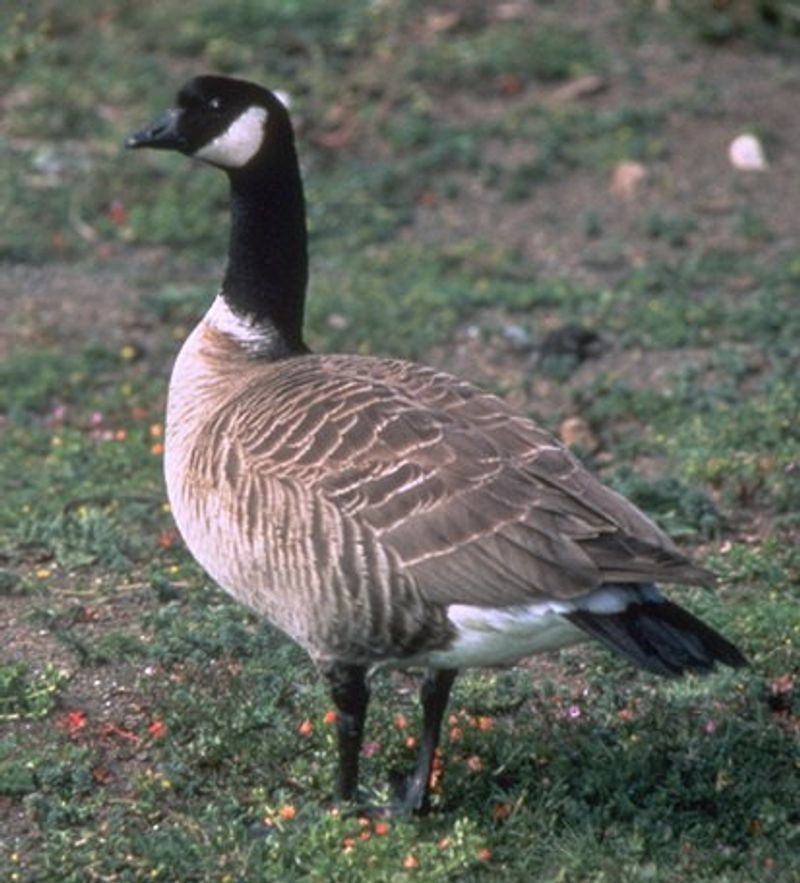
The cackling goose is a species of bird found throughout North America and East Asia. It is a member of the Anatidae family, which includes ducks, geese, and swans. The cackling goose is a small-sized goose, with an average length of 21 inches and a wingspan of 36 inches.
They are grayish-brown with white patches on their wings and have a black head and neck with a white “cowl” around them. The cackling goose can be found in a variety of habitats, ranging from wetlands to grasslands to open fields.
They are mainly herbivorous, feeding on grasses, sedges, and grains. In the winter, they migrate south in large flocks to more temperate climates, where they can find food more easily.
The cackling goose is an important part of the avian community in North America and East Asia, and their numbers have been steadily increasing in recent years.
| Kingdom | Animalia |
| Phylum | Chordata |
| Class | Aves |
| Order | Anseriformes |
| Family | Anatidae |
| Genus | Branta |
| Species | B. hutchinsii |
6. Red-Throated Loon

The red-throated loon, also known as the red-throated diver, is a species of migratory bird found in the northern hemisphere.
It is the most widely distributed member of the loon or diver family, found throughout the Arctic regions during the breeding season and in northern coastal waters for the winter. This species of bird is an aquatic bird, meaning it spends a lot of its time in the water.
The red-throated loon has a distinctive red throat, which makes it easy to distinguish from other species of loons. It is a large bird, typically weighing around 3.5 pounds and measuring up to 27 inches in length. The red-throated loon is an expert swimmer and diver.
It uses its wings to propel itself underwater in search of food such as fish, mollusks, and aquatic insects. The bird also feeds on small birds, amphibians, and crustaceans.
Its wings are designed for powerful, graceful flight, enabling it to cover large distances during migration. The red-throated loon is an important species for the environment.
It helps to keep the water clean by eating fish, mollusks, and aquatic insects, thereby preventing overpopulation. The bird is also an important food source for predators such as bald eagles and ospreys.
In addition, its presence helps to preserve the delicate balance of ecosystems in the Arctic regions. Overall, the red-throated loon is an important species both ecologically and economically.
Its presence in the northern hemisphere helps to maintain a healthy environment while also providing a valuable source of food for predators. The bird’s migratory behavior also helps to ensure its long-term survival in the wild.
| Kingdom | Animalia |
| Phylum | Chordata |
| Class | Aves |
| Order | Gaviiformes |
| Family | Gaviidae |
| Genus | Gavia |
| Species | G. stellata |
7. White-Rumped Sandpiper

The white-rumped sandpiper is a small species of shorebird that breeds in Canada and Alaska’s northern tundra regions. It can be difficult to tell apart from other small shorebirds that share similar characteristics, which are referred to as “peeps” or “stints”.
As a result, this species is not often seen in its natural habitat. Despite being a small bird, the white-rumped sandpiper is capable of surviving in the harsh conditions of the tundra, making it well adapted to the environment.
They have several key traits that help them survive, such as strong legs and feet that allow them to run quickly across the landscape, as well as waterproof feathers that help keep them warm and dry.
They also have a distinctive white rump patch that can be used to identify them from other species. During the summer months, white-rumped sandpipers migrate southward, often joining up with large flocks of other shorebirds.
During this time, they can be spotted more easily as they travel together in large numbers.
| Kingdom | Animalia |
| Phylum | Chordata |
| Class | Aves |
| Order | Charadriiformes |
| Family | Scolopacidae |
| Genus | Calidris |
| Species | C. fuscicollis |
8. American Golden Plover

The American golden plover is a species of migratory bird in the genus Pluvialis. Its genus name is derived from Latin, meaning relating to rain, which is derived from the Latin word “pluvia”, meaning rain.
This name was given to the golden plover because it was believed that they flocked together whenever rain was imminent. The species name for the American golden plover is “Dominica”, which is derived from Santo Domingo, a Caribbean island also known as Hispaniola.
This is where the bird was first discovered by early settlers, and it was later named after the island.
| Kingdom | Animalia |
| Phylum | Chordata |
| Class | Aves |
| Order | Charadriiformes |
| Family | Charadriidae |
| Genus | Pluvialis |
| Species | P. dominica |
9. Glaucous Gull

The glaucous gull is a large species of gull that is among the largest in the world. It is found in Arctic regions of the northern hemisphere and migrates southward during the winter season.
Its genus name, Larus, is derived from the Latin language and is thought to refer to a type of large seabird. The glaucous gull is a powerful flier and is known to feed on a wide variety of food sources, including fish, crustaceans, and small mammals.
It is found on coasts, bays, and islands near the Arctic Ocean, and also on inland lakes and rivers. During the breeding season, the glaucous gull typically nests in colonies, with each pair claiming an area of ground or a cliff ledge.
The female lays two or three eggs in a shallow scrape or depression in the ground, which are incubated by both sexes. The chicks are fed by both parents and fledge around 35 days after hatching.
| Kingdom | Animalia |
| Phylum | Chordata |
| Class | Aves |
| Order | Charadriiformes |
| Family | Laridae |
| Genus | Larus |
| Species | L. hyperboreus |
10. Grey Phalarope
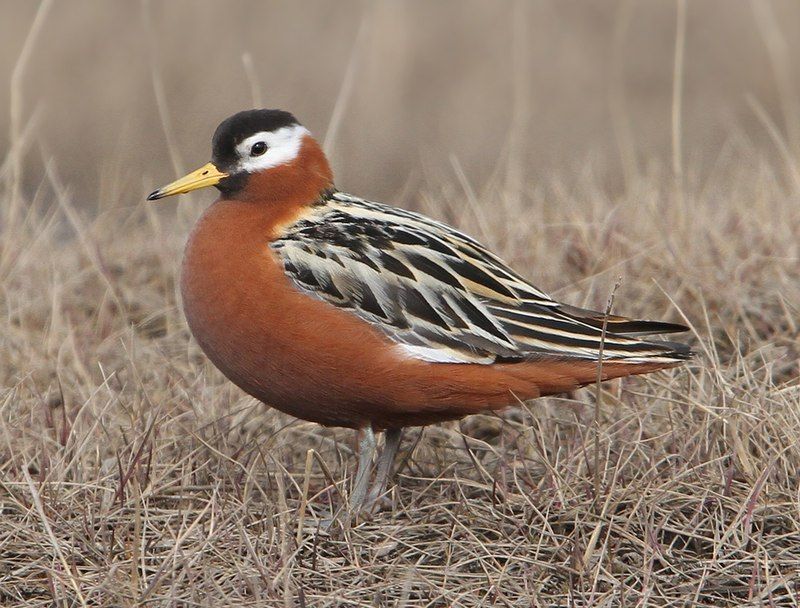
The red phalarope and grey phalarope are small waders found in the Arctic regions of North America and Eurasia. They breed in the Arctic during the summer months and then migrate to the warmer waters of the tropical oceans for the winter.
This is unusual for a wader, which normally migrates over land, as the phalaropes migrate mainly on oceanic routes instead. Their migration is essential for their survival, as they would not be able to survive the harsh winter conditions in the Arctic.
It is a fascinating sight to see these small waders, which are usually found in wetland habitats, making their way across the open ocean.
| Kingdom | Animalia |
| Phylum | Chordata |
| Class | Aves |
| Order | Charadriiformes |
| Family | Scolopacidae |
| Genus | Phalaropus |
| Species | P. fulicarius |
11. Snowy Owl
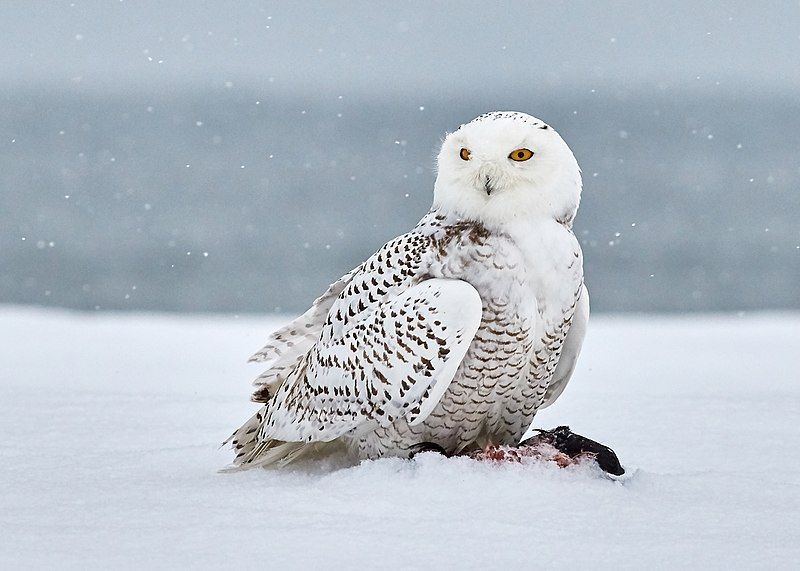
The snowy owl is a large, white owl of the true owl family, and is native to both North America and the Palearctic. It is also known by the names polar owl, white owl, and Arctic owl.
Snowy owls are typically found in the Arctic regions of both continents, where they have adapted to the cold and harsh environment of the tundra. These owls typically breed in the tundra, where they are able to find ample food sources and nesting materials.
Their white plumages are perfect for blending into the snow, allowing them to remain hidden and safe from predators. They are also able to endure freezing temperatures due to their thick feathers and layers of fat.
Snowy owls are a wonderful and majestic sight to behold in the Arctic regions, where they have lived and bred for centuries.
| Kingdom | Animalia |
| Phylum | Chordata |
| Class | Aves |
| Order | Strigiformes |
| Family | Strigidae |
| Genus | Bubo |
| Species | B. scandiacus |
12. Red-Necked Phalarope
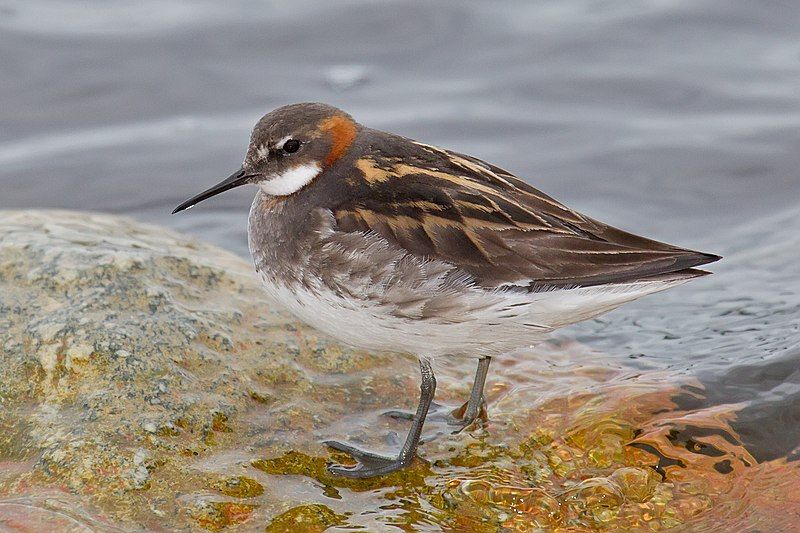
The red-necked phalarope is a small wading bird, found in a variety of habitats across the world. It is commonly referred to as the northern phalarope or hyperborean phalarope.
This species breeds in the Arctic regions of North America and Eurasia, making it one of the most northerly species of wader. During the winter months, this species migrates to warmer climates, spending its time at sea in tropical oceans, which is uncommon among wading birds.
Its diet consists mainly of small aquatic insects, crustaceans, and mollusks, which it picks off the surface of the water. This species is a medium-sized wader, about 20 cm in length, and is characterized by its bright reddish-brown neck and head.
It has grayish-brown upperparts and white underparts. The underside of the wings also has a distinctive white stripe.
| Kingdom | Animalia |
| Phylum | Chordata |
| Class | Aves |
| Order | Charadriiformes |
| Family | Scolopacidae |
| Genus | Phalaropus |
| Species | P. lobatus |
13. Osprey

The osprey is a large bird of prey that is found all over the world. Also known by the names sea hawk, river hawk, and fish hawk, the osprey is an incredibly powerful hunter that specializes in eating fish. It is a diurnal creature, meaning that it is most active during the day.
In terms of size, the osprey can reach over 60 centimeters in length, and its wingspan is a remarkable 180 centimeters. Its feathers are predominantly brown on the upperparts and greyish on the head and underparts.
The Osprey is an amazing creature that has adapted to living in almost any environment. It hunts by hovering above bodies of water and then diving into the water to catch its prey. Its sharp talons and powerful wings make it an incredibly effective hunter.
The Osprey is a fascinating species, and its incredible hunting ability is a testament to its evolutionary success.
| Kingdom | Animalia |
| Phylum | Chordata |
| Class | Aves |
| Order | Accipitriformes |
| Family | Pandionidae |
| Genus | Pandion |
| Species | P. haliaetus |
14. Semipalmated Plover

The semipalmated plover is a small bird belonging to the family Charadriidae, commonly referred to as plovers. The name Charadrius is derived from a Late Latin word, which was used to describe a yellowish bird mentioned in the fourth-century Vulgate.
This word itself is derived from the Ancient Greek kharadrios, which was used to describe a bird that was found in ravines and river valleys.
The specific species name of the semipalmated plover, semipalmated, is Latin in origin and is derived from the words semi, meaning “half”, and Palma, which means “palm”. This likely refers to the distinctive markings on the wings of the plover which appear to be half a palm.
| Kingdom | Animalia |
| Phylum | Chordata |
| Class | Aves |
| Order | Charadriiformes |
| Family | Charadriidae |
| Genus | Charadrius |
| Species | C. semipalmatus |
15. Pied-Billed Grebe
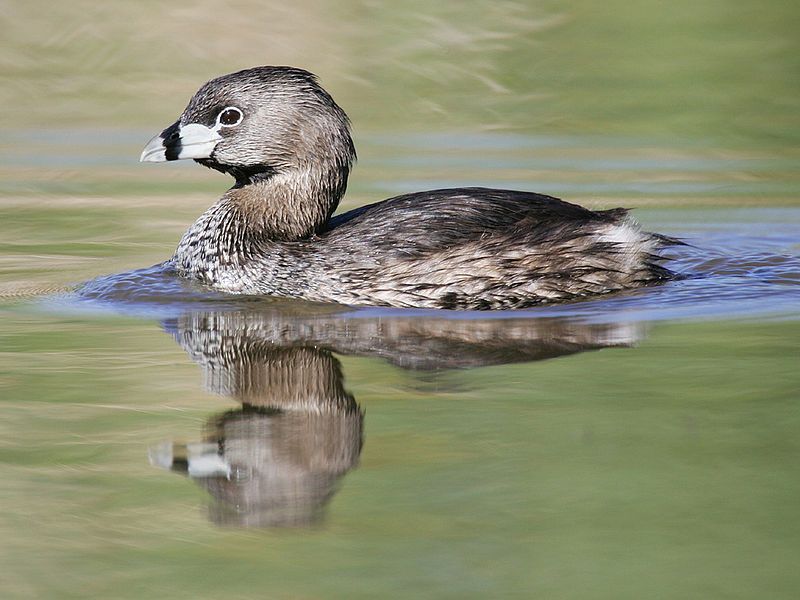
The Pied-billed Grebe is a species of water bird belonging to the Grebe family. It is the only remaining member of the genus Podilymbus, after the extinction of the Atitlán grebe. It is found in ponds all across the Americas, from Canada to Argentina.
The Pied-Billed Grebe has a distinctive black and white plumage, with a black bill and yellowish legs.
It is a small bird, measuring only about 10 inches long and weighing up to 5 ounces. The Pied-billed Grebe is a solitary species, and it prefers to live in small bodies of water with dense vegetation.
It feeds on small fish, aquatic insects, and crustaceans that it catches from the surface of the water.
It is an excellent swimmer, using its feet to propel itself through the water. The Pied-billed Grebe is a vocal species, producing a variety of croaks, whistles, and other sounds.
During breeding season, it performs a spectacular courtship display, involving a wide range of vocalizations and movements.
The male and female will perform a graceful duet, calling to one another while swimming in circles around each other. The Pied-billed Grebe is a shy species that is rarely seen, but it is an important part of the wetland ecosystem.
Its presence helps keep the water clean by feeding on aquatic insects, and it also serves as a food source for larger predators. Its continued existence is a testament to the importance of protecting fragile wetland habitats.
| Kingdom | Animalia |
| Phylum | Chordata |
| Class | Aves |
| Order | Podicipediformes |
| Family | Podicipedidae |
| Genus | Podilymbus |
| Species | P. podiceps |
16. Thick-Billed Murre
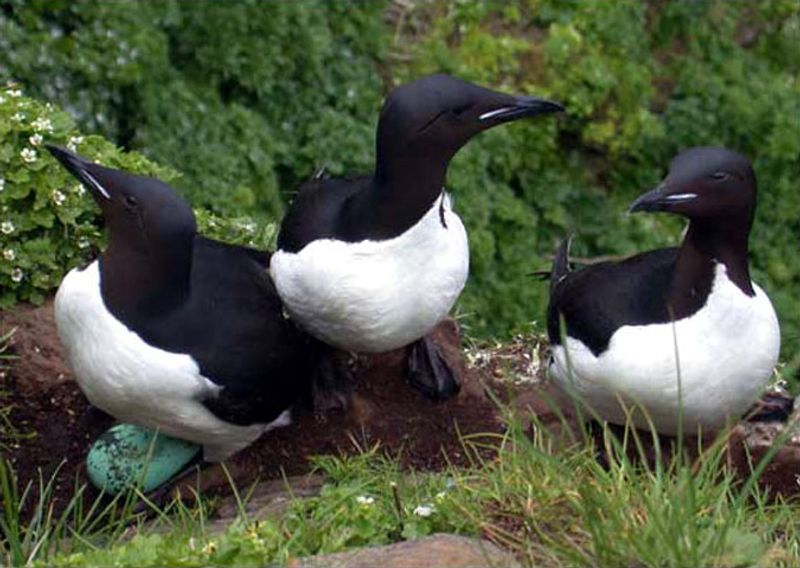
The thick-billed murre, also known as Brünnich’s guillemot, is a species of seabird that belongs to the auk family. This bird is named after Danish zoologist Morten Thrane Brünnich, who first identified and named the species in the 18th century.
In addition, there is a subspecies of the thick-billed murre, known as Uria lomvia arra, which is found in the North Pacific Ocean.
This subspecies is characterized by its very deep black feathers and is also referred to as Pallas’ murre, after German zoologist Peter Simon Pallas, who first described the species in the 18th century.
The thick-billed murre is a large seabird, usually measuring between 33 and 38 cm in length. It has a conspicuous bill that is thicker and longer than that of other auk species, giving it its name.
The thick-billed murre is a social bird and can be found in large colonies on coastal cliffs and islands. It feeds mainly on small fish and crustaceans, which it dives for underwater. The thick-billed murre is a common species and is not threatened.
| Kingdom | Animalia |
| Phylum | Chordata |
| Class | Aves |
| Order | Charadriiformes |
| Family | Alcidae |
| Genus | Uria |
| Species | U. lomvia |
17. Buff-Breasted Sandpiper
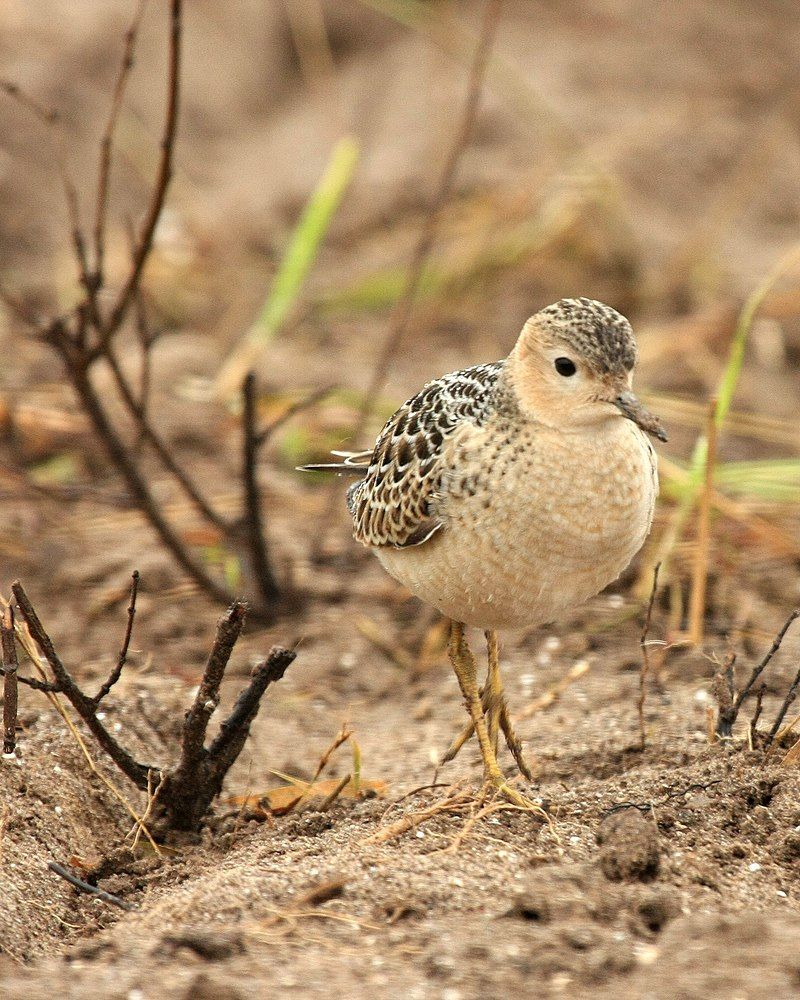
The buff-breasted sandpiper is a small shorebird from the calidrid sandpiper family. Its species name, subruficollis, is derived from the Latin words subrufus, which means “reddish”, and Collis, which means “-necked/-throated”.
This species’ name reflects the buff-breasted sandpiper’s reddish-brown neck and breast area. They prefer to migrate during the summer season to areas of open grassland, wet meadows, and wetlands.
These shorebirds are often seen foraging for food in shallow waters or along the edges of wetland areas. They feed on various insects, worms, and crustaceans.
During the breeding season, the buff-breasted sandpiper will make nests on the ground, often near water, and lay around four to five eggs. They are a unique species and are a delight to watch.
| Kingdom | Animalia |
| Phylum | Chordata |
| Class | Aves |
| Order | Charadriiformes |
| Family | Scolopacidae |
| Genus | Calidris |
| Species | C. subruficollis |
18. American Wigeon
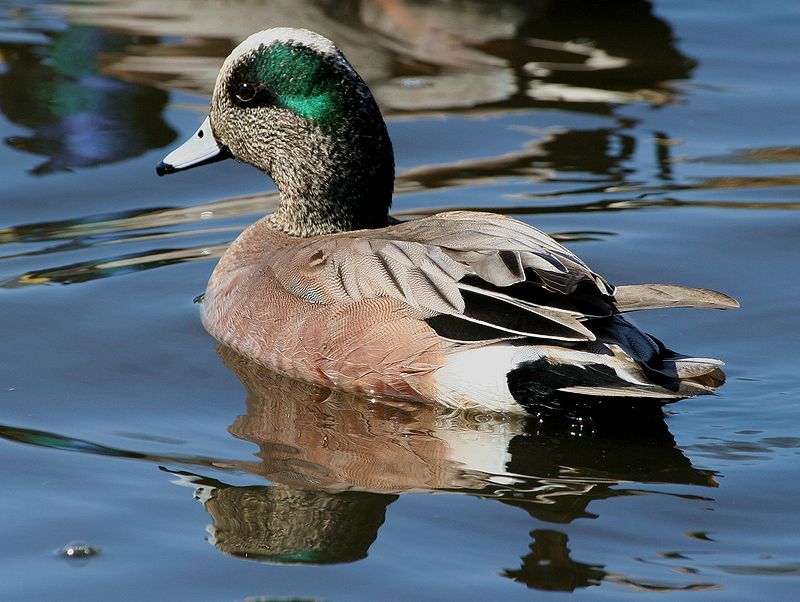
The American wigeon is a species of dabbling duck that inhabits North America. It is commonly referred to as the baldpate due to its distinctive white-and-gray head plumage.
The American wigeon was once classified in the genus Anas, however, it is now grouped in the genus Mareca with all other wigeon species. This species is the New World equivalent of the Eurasian wigeon, which is found in Europe, Asia, and parts of Africa.
The American wigeon is a medium-sized duck that typically measures 17 inches long and weighs between 1.5 and 2.5 pounds. It is mostly gray-brown in color, with a white face and neck, a dark crown, and a light-colored bill.
The male American wigeon has a white patch on its forehead, earning it the nickname “baldpate”. The female lacks this white patch and is slightly smaller than the male. The American wigeon feeds mainly on plant matter, such as grasses, sedges, and aquatic vegetation.
It also eats small invertebrates, such as insects and mollusks. The species is generally found in shallow wetlands, such as ponds, marshes, and shallow lakes. It breeds in the northern parts of its range and migrates south during the winter months.
The American wigeon is considered to be a species of least concern, due to its large population and wide geographic range. It is hunted in many areas, and its meat is considered a delicacy. The species is also vulnerable to habitat loss due to wetland destruction and pollution.
Despite these threats, the American wigeon remains abundant and widespread in its range.
| Kingdom | Animalia |
| Phylum | Chordata |
| Class | Aves |
| Order | Anseriformes |
| Family | Anatidae |
| Genus | Mareca |
| Species | M. americana |
19. Northern Wheatear
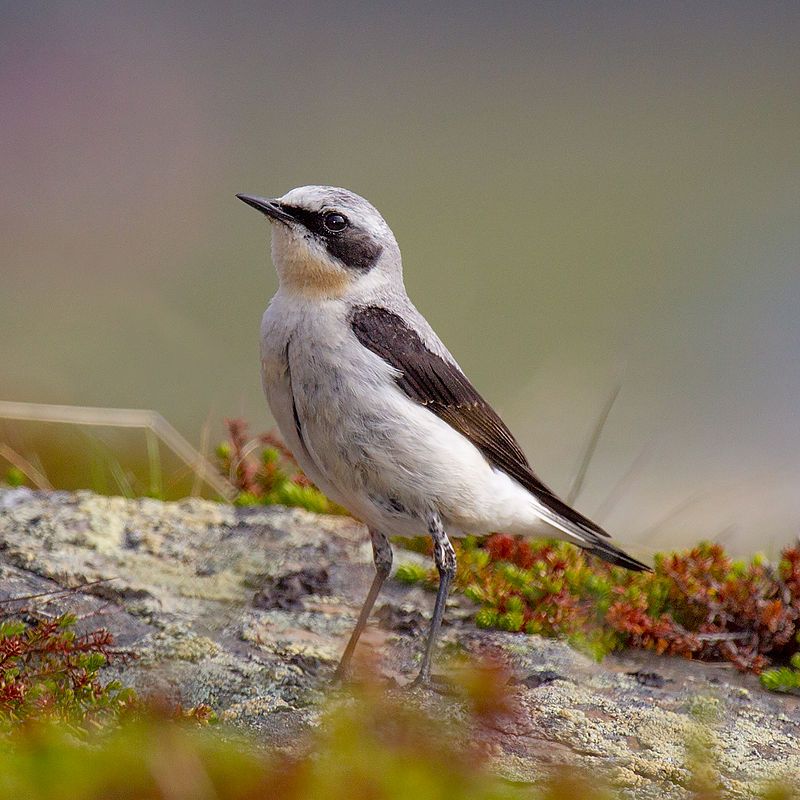
The northern wheatear, also known as the wheatear, is a small but distinctive bird in the passerine family. It has traditionally been classified as a member of the thrush family Turdidae but has since been reclassified as an Old World flycatcher in the genus Oenanthe.
The northern wheatear is the most widespread species of this genus in Europe and North and Central Asia, meaning it can be found in a wide range of habitats.
Its unique plumage and distinctive call make it an easy species to identify. The northern wheatear is a small bird, measuring roughly 15 cm in length and weighing around 20-30 g.
It has a light brown back and underparts, with a white throat and chest, and black spots on its wings and tail. Its head is mainly gray, with a white eye ring and a black stripe running through its eyes. The northern wheatear also has a black tail and a distinctive white rump.
Its call is a short, high-pitched trill which is often repeated. The northern wheatear is a migratory species, with individuals traveling from northern Europe and Asia in the summer, and returning south in the winter.
They can be found in a wide range of habitats, including open fields, grasslands, and rocky hillsides.
They feed mainly on insects, but will also eat other small invertebrates, berries, and seeds. In conclusion, the northern wheatear is a small passerine bird that was formerly classified as a member of the thrush family Turdidae but is now more generally considered to be an Old World flycatcher, Muscicapidae.
It is the most widespread member of the wheatear genus Oenanthe in Europe and North and Central Asia and can be identified by its distinctive plumage and call. The northern wheatear is a migratory species and can be found in a wide range of habitats.
| Kingdom | Animalia |
| Phylum | Chordata |
| Class | Aves |
| Order | Passeriformes |
| Family | Muscicapidae |
| Genus | Oenanthe |
| Species | O. oenanthe |
20. Common Ringed Plover
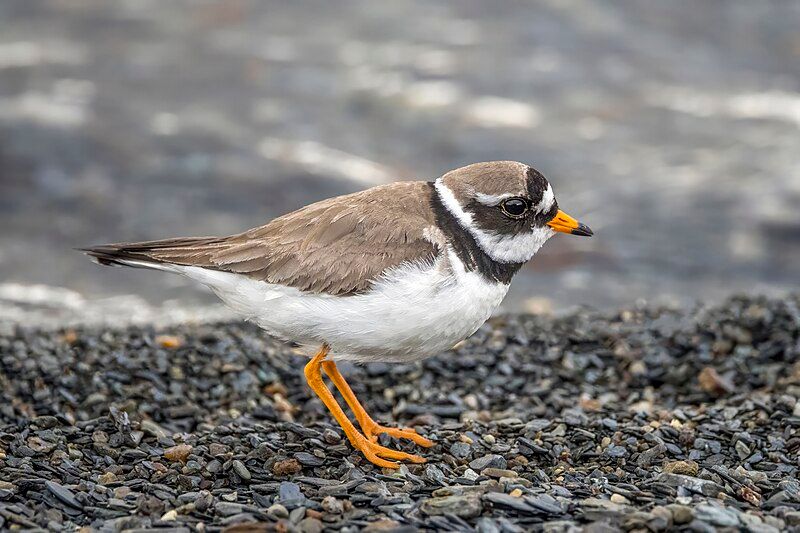
The common ringed plover is a species of small plover that can be found in parts of Arctic Eurasia. It belongs to the genus Charadrius, which is a Late Latin word for a type of yellowish bird that was mentioned in the fourth-century Vulgate.
The word Charadrius is further derived from the Ancient Greek word ‘kharadrios’, which referred to a bird that inhabited ravines and river valleys. This species of plover is known to breed in the same habitats, showing that its name is deeply rooted in its biology and ecology.
| Kingdom | Animalia |
| Phylum | Chordata |
| Class | Aves |
| Order | Charadriiformes |
| Family | Charadriidae |
| Genus | Charadrius |
| Species | C. hiaticula |
21. Ivory Gull
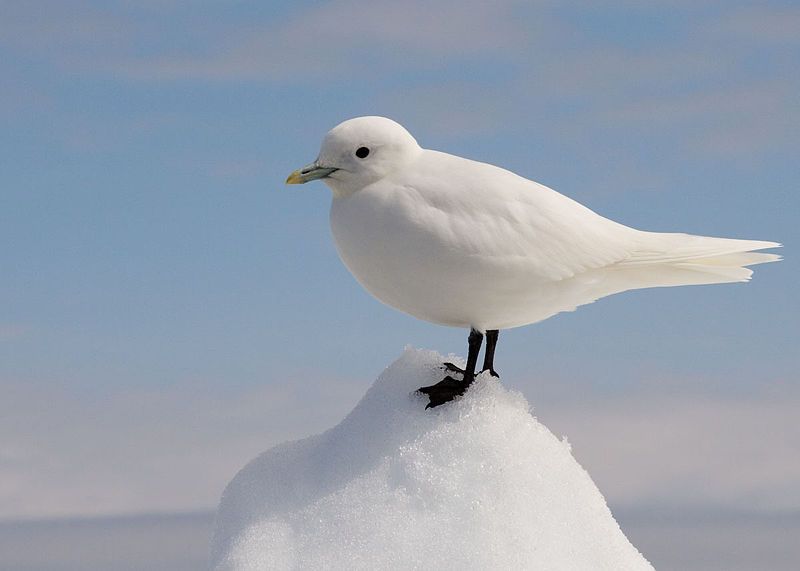
The ivory gull is a small species of gull in the genus Pagophila. It is the only species of gull in this genus. It breeds in the high Arctic, with a circumpolar distribution. This means that it can be found throughout Greenland, northernmost North America, and Eurasia.
The ivory gull is an important species of the Arctic and is a key indicator of the health of the Arctic environment. It is a small, white gull, with black markings on its wings.
Its diet is mainly composed of small fish, but it will also feed on insects, crustaceans, and carrion. It nests in colonies on cliffs or in rocky areas, laying 2 to 3 eggs.
The ivory gull is classified as a vulnerable species, due to its declining population and the threats it faces from climate change, oil and gas activities, and pollution.
| Kingdom | Animalia |
| Phylum | Chordata |
| Class | Aves |
| Order | Charadriiformes |
| Family | Laridae |
| Genus | Pagophila |
| Species | P. eburnea |
22. Sabine’s Gull
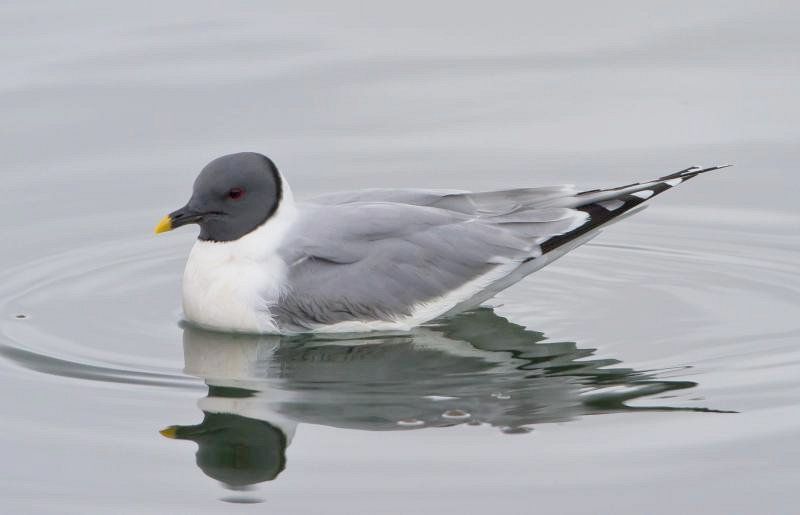
Sabine’s gull is a unique species of gull and is the only species placed in the genus Xema. It is a small gull with a distinctive forked tail, and it is sometimes known as the fork-tailed gull or xeme.
This species breeds in colonies on coasts and tundra, where it builds its nest on the ground. The nest is lined with grass and two or three spotted, olive-brown eggs are laid.
Outside of the breeding season, Sabine’s gull is pelagic, meaning it is more likely to be seen out at sea than on land. It is a migratory species that spends its summer in the Arctic and its winter in the southern oceans near Antarctica.
As such, it is considered a long-distance migrant and a nomadic species, as its movements are unpredictable and often not well understood.
| Kingdom | Animalia |
| Phylum | Chordata |
| Class | Aves |
| Order | Charadriiformes |
| Family | Laridae |
| Genus | Xema |
| Species | X. sabini |
Conclusion
Baffin Island is home to an incredible variety of bird species, from the majestic snowy owl to the colorful ptarmigan. This diversity of birds helps to create a vibrant and dynamic ecosystem that is supported by the abundance of natural resources the island offers.
Birds play an important role in the maintenance of the island’s healthy environment, and the protection of these species is essential for the continued success of the environment.
With the proper conservation efforts, Baffin Island can continue to be a haven for birds and the many other species that rely on them.